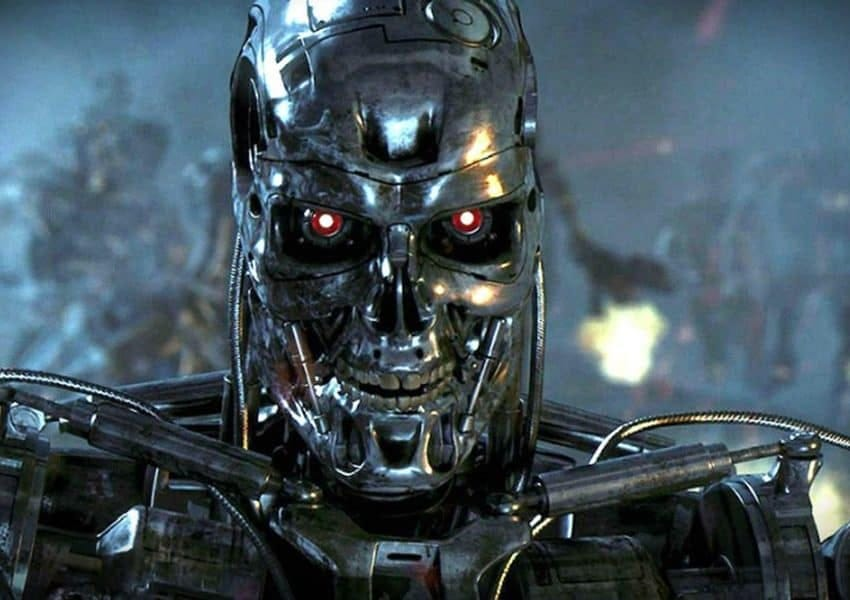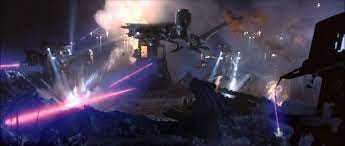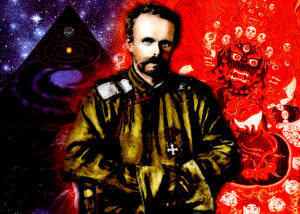Terminator Future

Heideggers “The Question Concerning Technology” and The Terminator
Enframing.
In “The Question Concerning Technology,” Martin Heidegger claims that the essence of technology is “Enframing,” and that this is nothing technological. How can that be? If technology is a tool with a use-value for us, its creators, how can its essence be anything other than its function? Technology is inert, therefore it’s essence must be no more than the purpose or meaning we apply to it. Not so, according to Heidegger. In fact, the essence of technology is not in technology at all, but in *us.* But this essence is not *our* essence, the essence of technology – Enframing – is not the essence of Being in its totality, rather it is one aspect of Being that conceals other aspects. If we are trapped in the essence of technology, if technology “enframes” us, then we are unable to access the other facets of Being, and the essence of humanity is reduced to the essence of technology.
Heidegger says that Enframing is like unto a bookcase that holds and surrounds a collection of books, or a skeleton upon which a body hangs. In the latter example, technology supports or undergirds our culture or our Being, in the former it houses or encases us. Without this frame, our body collapses into a formless, inert blob, and without this bookcase our books end up piled about the house chaotically, to be forgotten in oblivion in some dark corner. A simpler, more direct example may shed further light on Heideggers concept, that of a picture frame. The four borders of the frame encapsulate the scene depicted in the photo or painting: the frame is not of the picture but it is essential to its display and to its very livelihood. A picture, as such, is a mere representation of life, and the frame delineates the boundary between it and real life. In this sense we can understand how Enframing is the essence of technology and not of humanity, bound up with us but not definitive of our Being. The simulacrum contained within the picture frame can never escape the boundaries and participate in the fullness of Being, just like humanity within the frame of technology cannot escape its boundaries and experience the fullness of human existence.
Heidegger speaks of concealment and unconcealment, in which one aspect of or relation to Being will obscure another once it is accessed by humanity. Once we are Enframed by technology, in other words, we cannot relate to Being in its fullness as perhaps we once did prior to this relationship with technology. However, as we’ve said, Enframing is nothing technological. Rather, it is a sort of mindset that grips a culture at a certain point in its development. Spengler, from whom Heidegger derives much of his thought, not least in this essay, says that a culture moves through different phases, and that during these phases they are concerned with developing certain human capacities to their fullest potential. Within the Spenglerian model, it is possible for a culture to attain the height of a particular endeavor, after which it falls away from that practice, never to attain such perfection in expression again. Briefly, these endeavors are broad categories like “religion,” “art,” “law,” “language,” and “economics,” Once these activities attain the apex of their form, the culture is capable of no more than reproduction of the same things over and over, at best, and at worse they devolve into dysfunctional, chaotic, or needlessly cumbersome parodies of themselves. According to Spengler, a civilization may persist in this ossified state for millenia.
Simply consider art to understand there is more to this than it may appear. Renaissance Italy displayed sculptures like the Pieta and paintings like Da Vinci’s Mona Lisa, while the modern West has purely chaotic Pollacks and intentionally ugly, malformed Picassos in its museums, and sculptures of anal plugs and obese women with dangling labias displayed in its cities. When a culture is producing masterpieces, it is gripped by the essence of art, but once it devolves into reproduction, or loses its skilled architects and engineers – thereby losing the means of creating the works of the past – its relationship to Being has changed, it has entered a new mindset, and cannot re-access the previous one. In this way, human culture’s relationship to Being is always in flux. But according to Spengler, once a certain ineffable, terminal point is reached, the culture becomes exhausted, and all of the forms it created in the various aforementioned fields can never be reaccessessed or evolved, but only copied endlessly, and all cultural production becomes living fossils of a once creative society.
Heidegger puts it another way, in “A Letter on Humanism,” wherein he says this ossified condition of Spenglers is a sort of “Homelessness” defined by the “abandonment of Being by beings,” and that it is the “oblivion of Being.” In other words, we become trapped in the final mindset of civilization, that of pure quantification. This, according to Spengler, is the petrified, final stage of the economic thought-form, and economics is itself the final human endeavor worked out by a culture before it enters its winter, or homeless phase. And *this* is the essence of technology, pure quantification, which is itself nothing technological. It is the reduction of all Being to quantification, in which all objects are reduced to their use-value or their potential use-value. When one considers a tool, this makes sense, and for millenia this relationship to technology was simply one aspect of the totality of Being, incorporated into the fullness of our essence.
We related to the world as a cosmological whole in which entities were related to in their essence and we related to them from our essence and this relationship, rather than concealing one aspect of either essence, enhanced it and helped humans attain their Being as a whole. In other words, our use of technology once entrenched our embeddedness in the world around, but now with Enframing, it causes us to stand apart from it and consider the world – and ourselves – as a source of energy for extraction. This standing apart, which Heidegger names “Ek-sistence” in A Letter on Humanism, changes the relation of entities in the world from one of integrated components to that of “standing reserve.” This also enunciates Heidegger’s distinction of physis versus poiesis. Poiesis is something growing into itself out of itself, like a flower emerging from what was once a seed. Physis, however, is when an entity actualizes its potential only after the action of an outside source. Artistic Man, making great sculptures and paintings, cannot do so without certain tools, without the employment of technology in a certain form, in this case the chisel or the paintbrush. Without technology of a certain sort, man can never actualize his potential as an artist. But as we shall see, now that the world around is reduced to standing reserve, entities only act upon one another in a parasitical way, draining from them their potential rather than facilitating their flourishing.
The example Heidegger uses is a watermill, and Kurosawa dramatizes this in his vignette “Village of the Watermills” in the film Dreams. In short, the watermill passively siphons off energy from the river in order to increase the use-value of human tools, while both the river and the humans using it retain their “riverness” or humanity. The river is still viewed *as a river* in all its dynamic functions which, taken together, constitute its whole, not merely as a harboror of fish, a means of aquatic transportation, a source for water, or a provider of energy. Humans, in this relationship, do not view themselves as stewards or shapers of the river, but relations of its myriad qualities, and the river could not be reduced to one of these qualities. However, once humanity develops a new relationship to technology, the essence of the river morphs, which eventually morphs our essence as well. Once a hydroelectric dam is built on a river, that river is changed utterly, as is our relationship to it and, eventually, ourselves.
That river has become standing reserve now, and it only exists in any of its aforementioned capacities if we allow it. The dam – or any other industrial structure built on its banks – pollutes the river and negates its capacity to provide drinking water, harbor fish, and transport trade or people. In other words, the essence of technology – Enframing – reduces the river to disparate components to be accessed at will. It is no longer a totality, it is standing reserve. As we said earlier with mindset and relation to Being, the aspect of the river as a source of power conceals other aspects of its Being, as source of drinking water, vector for transport, etc. And we no longer relate to it as recipients of its bounty, but rather as its masters. Eventually, this changes our essence as much as the essence of the river. Enframing does this in several ways. First, other humans become standing reserve, as potential labor in factories or, as Spengler points out in late phase Rome, stock of slaves. Humans thereby are reduced from living actors in the world to units of energy for production.
Before one begins to imagine this is a Marxist critique of technology, we must consider one last, fundamental element of Enframing. According to Heidegger, economics is itself derivative of the true source of Enframing, namely, physics. The scientific revolution, as well as the industrial revolution, were kicked off after physics worked out the mathematical blueprint undergirding – or Enframing – all reality. In this perspective, reducing the living world of divinely animated beings, created by God and living for God, to blind mathematical formulations, eventually led to the disenchantment of the world and the reduction of entities from fully integrated components of one cosmological whole to mathematical units of energy waiting to be mined for utilitarian means. So now, according to Heidegger, our relationship to technology has an effect on humanity opposite to that of physis: rather than facilitating the actualization of our true human potential into the ”religious Being,” the “artistic Being,” etc, it reduces us to stock that need to be maintained like any herd. Heidegger ardently opposes the characterization of humans as the “rational animal” (see again A Letter on Humanism), but Enframing reduces us to just that: something that eats, breeds, and quantifies ad infinitum. The longer we “Ek-sist” in this mindset, the farther away we get from our essence. It may even be possible to imagine that, as the technological epoch grinds on, our humanity is chipped away at so much that we are, in fact, reduced to mere animals.
Terminator Futures
These concepts play out in dramatic fashion in James Cameron’s 1984 sci-fi classic, The Terminator. Specifically, the future world depicted in the film is the endpoint of our technological era, humanity after the singularity, the poesis of Enframing. The scenes that take place in the future are all at night, amidst the wreckage of our ruined civilization, while sentient robots hunt humans down and “terminate” them. In this scenario, humans are rats scurrying about the world-for-robots, a reality that is no longer the cosmological whole of humanity embedded in the world with other entities in the fullness of their essence. Instead, man in the Terminator future has been completely stripped of his essence, whereas the essence of technology has achieved its apogee.

In this sense, if humans are being exterminated, they are no longer even standing reserve, they are in fact totally superfluous, a waste product of an earlier era, not even harboring any potential use-value for technology to extract. Civilization has evolved beyond the point of needing humans, for pure quantification is the only facet of Enframing. In Terminator 2, the terminator explains that at some point, technology becomes “self-aware” and begins to fly unmanned warplanes, which as we’ve seen, they then use to begin wiping out human beings. But technology has no higher purpose, it only exists to perpetuate itself. And while these films may serve as some sort of warning for a future some – apparently – believe we may face, it is much more useful to us as a parable for our current relationship to Being: a relationship Heidegger enunciates in The Question Concerning Technology.
For example, both Heidegger and Spengler say that when people are in the throes of the economic mindset, or Enframing, they act not from the center of their Being but in a mimicry of the type of people who came before , when the culture was more vibrant. They both say, for example, that in this era people cycle through a stock of phrases to deploy during conversation, to speak without thinking, or that art calls up earlier forms and cobbles them together to produce lame imitations or reproductions of the masterworks from an earlier time, and that this activity reduces us to “das mann,” the “Them,” clones, or beings participating in an inauthentic existence. And we may consider the terminators themselves to be a horrifying depiction of this, skeletal carbon-copies of one another who literally scroll through a stock of phrases or reactions on an internal computer screen, preprogrammed actions that the machine cannot act outside of. In this sense, Enframing or quantification makes up every aspect of our existence, right down to the words one may say or actions one may take.
When we ask what is the essence of humanity, what we are asking is what attribute do we have that distinguishes us from all other life? Spengler actually says that it is our use of technology, that we are technological animals and that the West is the technological civilization. This is a strong argument, and perhaps Heidegger would agree, however he takes pains to highlight our speech, our art, and our thought are different aspects of our faculties that allow us to attain the purity of what it means to be a human being, and not simply a “rational animal.” In other words, we cannot be reduced to our rationality alone, however in the Terminator Future we are reduced to the meanest struggle for bare life, and this reduction or negation is perpetrated by technology.
One may ask if our current condition is much different than that of Kyle Reese and his compatriots, the last holdout of humanity. Our technology has outsourced for us all of our faculties, from the procurement of sustenance from massive plantations around the world, to the point-and-click, birth control-fueled sexual marketplace online and the replacement of real art with minutely pixelated CGI. These novelties strip away all the things that make us human and reduce us to mere units of stimulation and pleasure. It is not a coincidence that sexual copulation for the purpose or procreation is a central element to the salvation of humanity from the terminator future, for love and childbearing is one of the fundamental elements of Being, something sacralized by all human traditions prior to this technological era.
So while Heidegger describes Enframing as a mindset, or a relation to Being, that dictates the way we interact with the world and with ourselves, The Terminator depicts a world where humans live literally inside the frame of technology, and the drama of humanity is played out in starker and starker detail until it is “bare life,” a pitiful struggle for survival amidst the ruins of a world we once ruled. And this is depicted in science fiction quite often, from The Matrix wherein humans are explicitly a stock, mined for energy by artificial intelligence, or in Ready Player One, where humans strive and even fight to live inside the framework of the virtual world.
Heidegger’s solution, mentioned in TQCT but discussed more at length elsewhere, is for us to – among other things – embrace and hone those skills that make us human; art, thought, poetry. However, he goes on to say, later in his life, that he believes only a God can save us, and that all we can do is make art and wait for his arrival. This is the savior theme, embodied by the myth of John Connor in the film, and this savior is wholly contingent upon a human connection between Kyle Reese and Sarah Connor, who must engage in an authentic relationship with a purpose higher than mere sexual stimulation, a physis of two beings acting upon each other to create a third, more whole Being, and carry humanity into its future, to overcome mere quantification and escape the parameters created by Enframing.











